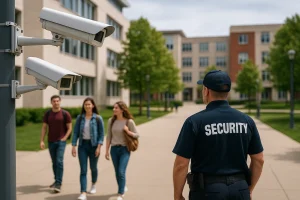The Evolution of Security Patrol Services in the Modern Era
Security has always been a paramount concern for civilizations, be it in the form of fortified castles in the Middle Ages or surveillance cameras in today’s digital age. The methods and means have evolved, and nowhere is this evolution more evident than in security patrol services. In the modern era, as threats become more multifaceted […]
By David Kerolles
August 27, 2023

Security has always been a paramount concern for civilizations, be it in the form of fortified castles in the Middle Ages or surveillance cameras in today’s digital age. The methods and means have evolved, and nowhere is this evolution more evident than in security patrol services. In the modern era, as threats become more multifaceted and technology advances at breakneck speed, the role of security patrol services has undergone significant transformations.
The Transition from Manpower to Tech-Power
In the past, security was heavily dependent on sheer manpower. Large numbers of guards were deployed to oversee vast areas, relying primarily on the human eye and intuition. Fast forward to the 21st century, and technology has begun to play an increasingly vital role. While human intuition is irreplaceable, tools such as surveillance cameras, motion detectors, and alarms have amplified the reach and efficiency of security personnel.
Diverse Range of Services
The modern security patrol is not just limited to guarding a property. Their services have diversified to include:
- Remote Monitoring: Using CCTV and advanced analytics, many firms now offer 24/7 remote monitoring of premises, allowing for quicker responses to potential threats.
- Mobile Patrols: Quick-response teams on the move, ensuring wider areas get sporadic but effective surveillance.
- Personal Security Details: Catering to VIPs or individuals at risk, offering specialized protection services.
- Event Security Management: Handling large crowds and potential threats in public events, from concerts to sports games.
Tools of the Trade
The modern security guard is equipped with a range of advanced tools:
- Drones: Offering aerial surveillance, especially useful for large properties or events.
- Advanced Communication Devices: Ensuring that guards can communicate in real-time with control rooms or other teams.
- Biometric Systems: Used extensively for access control, ensuring only authorized individuals can enter specific areas.
- Smart Sensors: Detecting everything from unauthorized access to fire or gas leaks.
Geographic Challenges and Solutions
Different regions come with their own set of challenges. In densely populated urban areas, the focus might be on digital threats, theft, or vandalism, requiring more tech-driven solutions. In contrast, remote or less populated areas might still rely on traditional patrolling methods but supplemented by tools like drones or long-range cameras. Coastal regions or borders might employ marine patrols or infrared sensors to detect intrusions.
Setting the Standard
As the demand for security patrol services grows globally, there’s been a push for standardizing practices. Organizations such as the International Foundation for Protection Officers (IFPO) and ASIS International provide certifications, training, and set guidelines to ensure that services across locations meet a minimum criterion.
Conclusion
The evolution of security patrol services in the modern era mirrors the broader shifts we see in society: a blend of human expertise and technological prowess. While challenges have grown in complexity, the tools and strategies employed by these services have also become more sophisticated, ensuring that safety remains a cornerstone, no matter the era.
Related Posts
Business Growth
Thinking of starting a security company? Don’t fall into the franchise trap. Discover why launching your own brand with support from The City Guards is the smarter, more profitable path. No franchise fees. No royalties. Just real tools, training, and guidance from former security CEOs.
By Michael Y. Daniels
May 17, 2025
Regulations
Security guards are an important part of any business, and it’s essential to ensure that your security guard force is up to date on the latest industry standards. In this article, we’ll explore the requirements, regulations, and best practices that govern the security guard industry. The Importance of Compliance Security guard companies are responsible for […]
By David Kerolles
August 23, 2023
Business Growth
What is SEO for Security Agencies ? Search engine optimization refers to optimizing your security guard business website to improve its visibility and rankings on search engines like Google and Bing. This helps attract more organic traffic, leads, and clients interested in security services. Security Guard SEO, a key component of Security Guard Marketing, involves […]
By David Kerolles
July 10, 2025





